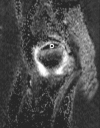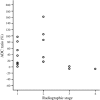Diffusion-weighted MRI reveals epiphyseal and metaphyseal abnormalities in Legg-Calvé-Perthes disease: a pilot study
- PMID: 21660596
- PMCID: PMC3171554
- DOI: 10.1007/s11999-011-1931-x
Diffusion-weighted MRI reveals epiphyseal and metaphyseal abnormalities in Legg-Calvé-Perthes disease: a pilot study
Abstract
Background: Legg-Calvé-Perthes disease (LCP) is thought to be associated with ischemic events in the femoral head. However, the types and patterns of reperfusion after these ischemic events are unclear.
Purposes: We therefore determined whether (1) there would be any age-related diffusion changes; (2) diffusion-weighted MR imaging would reveal ischemic damage; and (3) diffusion changes are correlated with prognostic MR findings in patients with LCP.
Methods: We prospectively performed conventional, perfusion, and diffusion-weighted MR imaging studies in 17 children with unilateral LCP. We then measured the apparent diffusion coefficient (ADC) values in the epiphysis and the metaphysis, and compared them with those of the contralateral normal side. Based on perfusion MR imaging, we assessed reperfusion to the epiphysis as either periphyseal or transphyseal. We studied T2-signal intensity changes in the metaphysis and the presence of focal physeal irregularity. We correlated diffusion changes with reperfusion to the epiphysis, T2-signal intensity change, and focal physeal irregularity.
Results: Normal diffusion decreased with age. In LCP hips, epiphyseal diffusion increased early and remained elevated through the healing stage. Six of the 17 patients who had a metaphyseal ADC greater than 50% over the normal side had 13 times greater odds of having an association with transphyseal reperfusion to the epiphysis. The increase of metaphyseal ADC also was associated with an increased T2-signal intensity in the metaphysis and presence of focal physeal irregularity.
Conclusions: Diffusion-weighted MR imaging can be used as a complimentary modality to evaluate ischemic tissue damage with a potential prognostic value in patients with LCP.
Figures






Similar articles
-
Diffusion-weighted magnetic resonance imaging of femoral head osteonecrosis in two groups of patients: Legg-Perthes-Calve and Avascular necrosis.Radiol Med. 2016 Mar;121(3):206-13. doi: 10.1007/s11547-015-0589-y. Epub 2015 Oct 13. Radiol Med. 2016. PMID: 26463713
-
Cartilaginous abnormalities and growth disturbances in Legg-Calvé-Perthes disease: evaluation with MR imaging.Radiology. 1995 Dec;197(3):767-73. doi: 10.1148/radiology.197.3.7480754. Radiology. 1995. PMID: 7480754
-
Prognosis value of early diffusion MRI in Legg Perthes Calvé disease.Orthop Traumatol Surg Res. 2014 May;100(3):317-21. doi: 10.1016/j.otsr.2013.12.025. Epub 2014 Apr 13. Orthop Traumatol Surg Res. 2014. PMID: 24725906
-
Can large doses of glucocorticoids lead to Perthes? a case report and review of the literature.BMC Pediatr. 2021 Aug 12;21(1):339. doi: 10.1186/s12887-021-02755-4. BMC Pediatr. 2021. PMID: 34384372 Free PMC article. Review.
-
Prognosis and prognostic factors of Legg-Calve-Perthes disease.J Pediatr Orthop. 2011 Sep;31(2 Suppl):S147-51. doi: 10.1097/BPO.0b013e318223b470. J Pediatr Orthop. 2011. PMID: 21857429 Review.
Cited by
-
Magnetic resonance imaging in children with sickle cell disease--detecting alterations in the apparent diffusion coefficient in hips with avascular necrosis.Pediatr Radiol. 2012 Jun;42(6):706-13. doi: 10.1007/s00247-011-2327-5. Epub 2011 Dec 27. Pediatr Radiol. 2012. PMID: 22200862
-
Effect of arterial deprivation on growing femoral epiphysis: quantitative magnetic resonance imaging using a piglet model.Korean J Radiol. 2015 May-Jun;16(3):617-25. doi: 10.3348/kjr.2015.16.3.617. Epub 2015 May 13. Korean J Radiol. 2015. PMID: 25995692 Free PMC article.
-
[Pediatric Hip Disorders].J Korean Soc Radiol. 2024 May;85(3):531-548. doi: 10.3348/jksr.2024.0021. Epub 2024 May 23. J Korean Soc Radiol. 2024. PMID: 38873372 Free PMC article. Review. Korean.
-
Perfusion magnetic resonance imaging correlates with the duration of stages and lateral pillar class in Legg-Calvé-Perthes disease.J Pediatr Soc North Am. 2024 Feb 28;6:100019. doi: 10.1016/j.jposna.2024.100019. eCollection 2024 Feb. J Pediatr Soc North Am. 2024. PMID: 40433248 Free PMC article.
-
Intravoxel incoherent motion (IVIM) detects femoral head ischemia in a piglet model of Legg-Calvé-Perthes disease.J Orthop Res. 2024 Apr;42(4):855-863. doi: 10.1002/jor.25733. Epub 2023 Dec 4. J Orthop Res. 2024. PMID: 37971281 Free PMC article.
References
-
- Baur A, Stabler A, Bruning R, Bartl R, Krodel A, Reiser M, Deimling M. Diffusion-weighted MR imaging of bone marrow: differentiation of benign versus pathologic compression fractures. Radiology. 1998;207:349–356. - PubMed
-
- Catterall A. The natural history of Perthes’ disease. J Bone Joint Surg Br. 1971;53:37–53. - PubMed
MeSH terms
LinkOut - more resources
Full Text Sources

